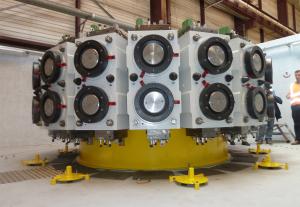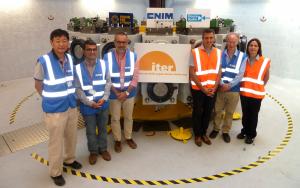An iron fist - in reverse
Knowing that the large electromagnetic forces at work during machine operation would cause stress over time to ITER's largest magnet set, engineers devised a compression system to "push back." The resilience of the solution—large composite "pre-compression" rings that will encircle the tips of the toroidal field coil cases at top and bottom—is about to be tested at a dedicated facility.
The European Domestic Agency is responsible for the fabrication of nine pre-compression rings (three top, three bottom and three spare). Weighing roughly 3 tonnes each, with an inner diameter of 5 metres, they are made of a fiberglass composite that consists of more than one billion minuscule glass fibres glued together using epoxy resin. This material—the result of an in-depth R&D program—has proved to be the best material for withstanding high loads and avoiding the circulation of current.



